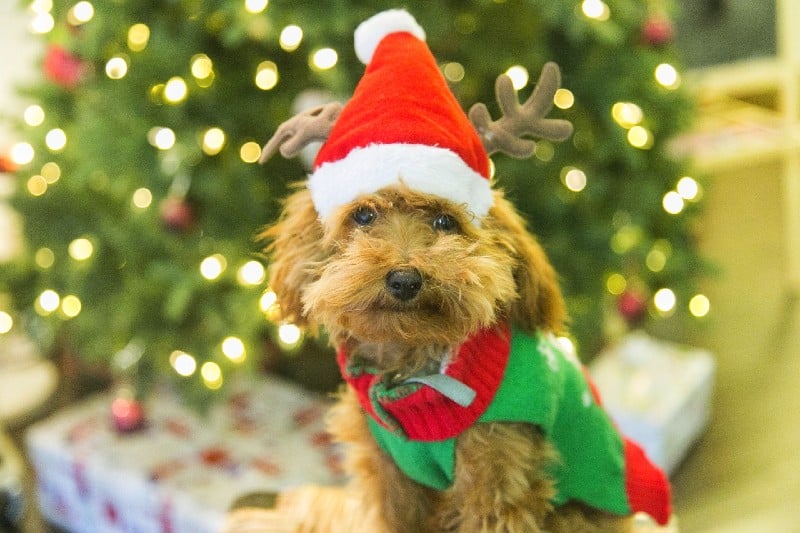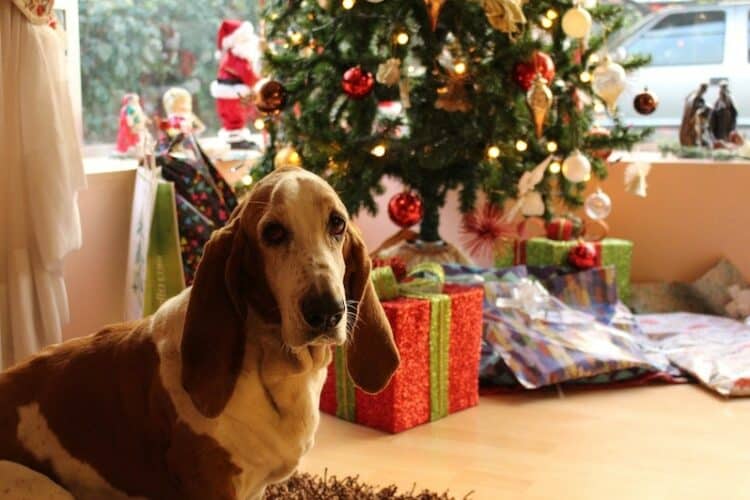With Christmas approaching, many dog owners want to put up a beautiful tree to enjoy the festive season. However, some dogs can see the Christmas tree as a chew toy— dogs and a tree decorated in sparkly lights aren’t always a good mix. Dogs may take an interest in both artificial or real Christmas trees, and their destruction can make a big mess, which can even be dangerous for your dog.
If you have recently gotten a new dog (especially a puppy), and you want to put up a tree for Christmas, we have some helpful tips for dog-proofing your Christmas tree.
The 7 Tips to Dog Proof a Christmas Tree
1. Use a Steady Base
Most Christmas tree bases are not sturdy enough alone to withstand being knocked over by your dog. If they begin chewing the tree, it can easily fall over and not only create a mess, but also potentially injure your dog by falling on them. Steadying the base can keep the tree stable enough so as not to be knocked over if your dog were to run into the tree, or if they tried to pull the ornaments off.
You can also try placing the tree in a corner, and placing a metal fence around the base to stop your dog from accessing the tree. Make sure the base is secured in a box, or that something is weighing it down to prevent curious dogs from tipping over the tree.

2. Cover Electric Wires
Dogs and sparkly Christmas lights don’t mix well, and can be dangerous. Dogs can chew the wires and get shocked, or the lights can get damaged and cause damage in the process. If your dog is a cord chewer an option is to unplug the Christmas tree lights until you can be home to supervise your dog around the lights. Otherwise, place a short metal fence around the tree where the exposed wires are.
Another option is to spray or rub a foul-tasting anti-chew substance on the exposed wires to make it unpleasant for your dog to chew. However, you will still need to cover or block the exposed wires from your dog, whilst using a bitter anti-chew solution such as bitter apple, which is non-toxic to pets. You can also try placing cord clips to keep them from hanging to the floor, which will keep them out of reach from small dogs and puppies.
3. Avoid Using Toxic Decorations
If you have both a dog and a Christmas tree, your options for tree decorations can be limited. Certain ornaments and decorative plants, such as holly, poinsettias, or the popular mistletoe, can be potentially dangerous for dogs and should not be used.
Dogs are curious creatures. Even if they are not known chewers, they may take an interest in ornaments or plants on the tree and want to chew them. Ornaments that are small enough for your dog to swallow are a potential danger as a choking risk or by causing a gastrointestinal obstruction.
Ornaments that are made of glass may injure your dog if chewed or broken so take care to keep these out of reach.
There are some toxins that can be found in ornaments, these include lead and batteries. If your pup gets hold of and swallows any of these contact your veterinarian for advice.

4. Place Ornaments Higher Up
Brightly colored, low-hanging ornaments are guaranteed to pique a curious dog’s interest. Placing the ornaments from the middle of the tree and up can prevent small dog breeds and puppies from easily accessing them.
If you have a real pine Christmas tree, the pine needles and sticks that fall off can be sharp and injure your dog’s mouth. So, you will need to sweep the floor to remove any fallen pine needles every day.
5. Do Not Place Food On the Tree
Placing food on a Christmas tree is not a good idea if you have dogs. Regardless of whether your dog chews the tree, they will likely try to get the food that they smell. Placing any food items, such as chocolates, higher up on the tree may still encourage your dog to jump or try to knock the tree down to get to it.
It’s important to note that chocolate is not good for your dog, as it is toxic for them.

6. Place The Tree On A Table Or High Surface
If you do not want to use barriers around the Christmas tree because it, understandably, may not look as good, you can try placing the tree on a sturdy dining table instead—out of your dog’s reach.
The higher surface ensures that your dog cannot easily reach the tree, which will prevent them from chewing it, knocking it down, or playing with the ornaments. This is also a good idea if you want to place presents underneath the tree, out of your dog’s view.
7. Closed Room
For persistent pooches leaving a trail of destruction in their path it is recommended that you place the tree in a room that they cannot access. If this is not possible as you have an open plan home, then make use of baby gates, dog crates or playpens as needed.

Final Thoughts
Dogs and Christmas trees do not always go well together, but if you follow these tips to ensure your dog’s safety around the tree, you will be able to enjoy the classic festive Christmas tree along with the joys of owning a dog. The holidays can be bright and special to share with your dog—just be aware of certain limits to the placement of your Christmas tree, and the decorations you use for it.
Featured Image Courtesy: Pexels














